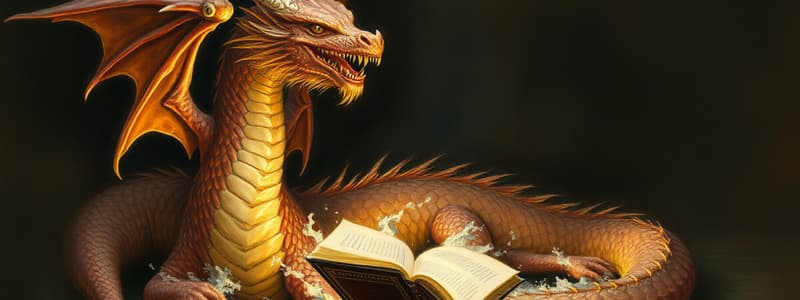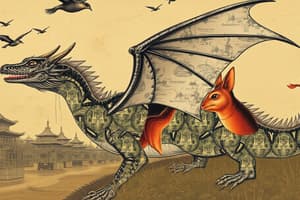Podcast
Questions and Answers
Which type of dragon resembles a snake and can grow up to 180 feet long?
Which type of dragon resembles a snake and can grow up to 180 feet long?
- Drakones (correct)
- Wyvern
- Campe
- Hydra
What is a distinguishing feature of wyverns compared to standard dragons?
What is a distinguishing feature of wyverns compared to standard dragons?
- They have no arms. (correct)
- They have venomous spiked tails.
- They have three heads.
- They have no legs.
What happens when a head is chopped off a Hydra?
What happens when a head is chopped off a Hydra?
- It transforms into a Wyvern.
- It dies instantly.
- It becomes venomous.
- Another head grows back. (correct)
Which dragon is noted as a challenge and historically guarded the gates of Tartarus?
Which dragon is noted as a challenge and historically guarded the gates of Tartarus?
What is a notable characteristic of wyverns' relationship with their owners?
What is a notable characteristic of wyverns' relationship with their owners?
Which dragon is described as being loyal and brave?
Which dragon is described as being loyal and brave?
What is a notable feature of the Red Dragon?
What is a notable feature of the Red Dragon?
Why might owning a dragon be significant according to the text?
Why might owning a dragon be significant according to the text?
What is suggested about the commitment required for owning a dragon?
What is suggested about the commitment required for owning a dragon?
What did King Vortigern find when he discovered the Red Dragon?
What did King Vortigern find when he discovered the Red Dragon?
Study Notes
Dragons as Pets
- Various types of dragons available, catering to different needs and preferences.
- Each dragon type presents unique characteristics and challenges as pets.
Drakones
- Resemble large snakes with sharp teeth.
- Can grow up to 180 feet long; requires a spacious environment.
- Functions as an excellent guard, surpassing traditional dogs in protection.
Wyverns
- Confused with standard dragons but lack arms, having only two wings and two legs.
- Potentially venomous spiked tails, though no complaints reported from stings.
- Known for loyalty and enjoys playing fetch, making them dog-like companions.
Hydra
- Distinctive for having at least nine heads; more heads grow back upon losing them.
- Blood is venomous; caution required when handling injuries to prevent exposure.
- Associated with mythological character Heracles, who used its blood to defeat a centaur.
Campe
- A challenging pet with a mix of snake-like body and a hundred feet.
- Historically guarded the gates of Tartarus and defeated by Zeus.
- Despite her fierce origins, Campe has a soft demeanor and seeks a calm home.
Y Ddraig Goch (the Red Dragon)
- Emblematic dragon from Wales, found by King Vortigern in a battle against a white dragon.
- Known for loyalty and bravery; significant cultural symbol as featured on the Welsh flag.
- Offers an opportunity to own a dragon with celebrity status in mythology.
Conclusion
- Encouragement to visit adoption shelters and consider dragon ownership.
- Emphasis on long-term commitment: "A dragon is for life, not just for your birthday!"
Studying That Suits You
Use AI to generate personalized quizzes and flashcards to suit your learning preferences.
Related Documents
Description
Explore the imaginative world of dragons in this Stage 3 quiz focusing on persuasive texts. Discover why dragons could make the ideal pet for you, as we delve into the attributes of various mythical creatures. Gain insights into famous dragons and learn to articulate compelling arguments about their suitability as pets.




